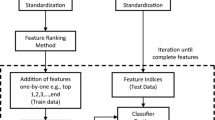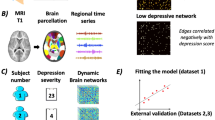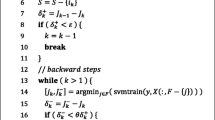Abstract
Major depressive disorder (MDD) as a psychiatric illness negatively affects the behavior and daily life of the patients.Therefore, the early MDD diagnosis can help to cure the patients more efficiently and prevent adverse effects, although its unclear manifestations make the early diagnosis challenging. Nowadays, many studies have proposed automatic early MDD diagnosis methods based on electroencephalogram (EEG) signals. This study also presents an automated EEG-based MDD diagnosis framework based on Dictionary learning (DL) approaches and functional connectivity features. Firstly, a feature space of MDD and healthy control (HC) participants were constructed via functional connectivity features.Next, DL-based classification approaches such as Label Consistent K-SVD (LC-KSVD) and Correlation-based Label Consistent K-SVD (CLC-KSVD) methods, were utilized to perform the classification task. A public dataset was used, consisting of EEG signals from 34 MDD patients and 30 HC subjects, to evaluate the proposed method. To validate the proposed method, 10-fold cross-validation technique with 100 iterations was employed, providing accuracy (AC), sensitivity (SE), specificity (SP), F1-score (F1), and false discovery rate (FDR) performance metrics. The results show that LC-KSVD2 and CLC-KSVD2 performed efficiently in classifying MDD and HC cases. The best classification performance was obtained by the LCKSVD2 method, with average AC of 99.0%, SE of 98.9%, SP of 99.2%, F1 of 99.0%, and FDR of 0.8%. According to the results, the proposed method provides an accurate performance and, therefore, it can be developed into a computer-aided diagnosis (CAD) tool for automatic MDD diagnosis.





Similar content being viewed by others
Data availability
The dataset is available and provided in https://figshare.com/articles/dataset/EEG_Data_New/4244171/2
Code availability
The code is not available yet.
References
Seligman M (1975) Helplessness: on depression, development, and death
Marcus M, Yasamy MT, van Ommeren MV, Chisholm D, Saxena S (2012) Depression: a global public health concern
World Health Organization (2001) The World Health Report 2001: mental health: new understanding, new hope. World Health Organization, Geneva
Castillo R, Carlat D, Millon T, Millon C, Meagher S, Grossman S, Association AP et al (2007) Diagnostic and statistical manual of mental disorders. American Psychiatric Association Press, Washington, DC
Folstein MF, Robins LN, Helzer JE (1983) The mini-mental state examination. Arch Gen Psychiatry 40(7):812–812
Hamilton M (1960) A rating scale for depression. J Neurol Neurosurg Psychiatry 23(1):56
Tuncer T, Dogan S, Akbal E (2019) A novel local senary pattern based epilepsy diagnosis system using EEG signals. Australas Phys Eng Sci Med 42(4):939–948
Li M, Sun X, Chen W (2020) Patient-specific seizure detection method using nonlinear mode decomposition for long-term EEG signals. Med Biol Eng Comput 58(12):3075–3088
Iešmantas T, Alzbutas R (2020) Convolutional neural network for detection and classification of seizures in clinical data. Med Biol Eng Comput 2020:1–14
Sairamya N, George ST, Balakrishnan R, Subathra M (2018) An effective approach to classify epileptic EEG signal using local neighbor gradient pattern transformation methods. Australas Phys Eng Sci Med 41(4):1029–1046
San-Segundo R, Gil-Martín M, D’Haro-Enríquez LF, Pardo JM (2019) Classification of epileptic EEG recordings using signal transforms and convolutional neural networks. Comput Biol Med 109:148–158
Tuncer T, Dogan S, Naik GR, Pławiak P (2021) Epilepsy attacks recognition based on 1d octal pattern, wavelet transform and EEG signals. Multimed Tools Appl 2021:1–22
Ansari AQ, Sharma P, Tripathi M (2020) Automatic seizure detection using neutrosophic classifier. Phys Eng Sci Med 43(3):1019–1028
Sadeghzadeh H, Hosseini-Nejad H, Salehi S (2019) Real-time epileptic seizure prediction based on online monitoring of pre-ictal features. Med Biol Eng Comput 57(11):2461–2469
You S, Cho BH, Yook S, Kim JY, Shon YM, Seo DW, Kim IY (2020) Unsupervised automatic seizure detection for focal-onset seizures recorded with behind-the-ear EEG using an anomaly-detecting generative adversarial network. Comput Methods Programs Biomed 193:105472
Hu X, Yuan S, Xu F, Leng Y, Yuan K, Yuan Q (2020) Scalp EEG classification using deep bi-lstm network for seizure detection. Comput Biol Med 124:103919
Hirschauer TJ, Adeli H, Buford JA (2015) Computer-aided diagnosis of Parkinson’s disease using enhanced probabilistic neural network. J Med Syst 39(11):179
Yuvaraj R, Murugappan M, Acharya UR, Adeli H, Ibrahim NM, Mesquita E (2016) Brain functional connectivity patterns for emotional state classification in Parkinson’s disease patients without dementia. Behav Brain Res 298:248–260
Liu G, Zhang Y, Hu Z, Du X, Wu W, Xu C, Wang X, Li S (2017) Complexity analysis of electroencephalogram dynamics in patients with Parkinson’s disease. Parkinson’s Dis 2017
Siuly S, Khare SK, Bajaj V, Wang H, Zhang Y (2020) A computerized method for automatic detection of schizophrenia using EEG signals. IEEE Trans Neural Syst Rehabil Eng 28(11):2390–2400
Shalbaf A, Bagherzadeh S, Maghsoudi A (2020) Transfer learning with deep convolutional neural network for automated detection of schizophrenia from EEG signals. Phys Eng Sci Med 2020:1–11
Thilakavathi B, Devi SS, Malaiappan M, Bhanu K (2019) EEG power spectrum analysis for schizophrenia during mental activity. Australas Phys Eng Sci Med 42(3):887–897
Goshvarpour A, Goshvarpour A (2020) Schizophrenia diagnosis using innovative EEG feature-level fusion schemes. Phys Eng Sci Med 43(1):227–238
Durongbhan P, Chen L, Zis P, De Marco M, Unwin ZC, Venneri A, He X, Li S, Zhao Y, Zhao Y et al (2019) A dementia classification framework using frequency and time-frequency features based on EEG signals. IEEE Trans Neural Syst Rehabil Eng 27(5):826–835
Vimala V, Ramar K, Ettappan M (2019) An intelligent sleep apnea classification system based on EEG signals. J Med Syst 43(2):36
Michielli N, Acharya UR, Molinari F (2019) Cascaded lstm recurrent neural network for automated sleep stage classification using single-channel EEG signals. Comput Biol Med 106:71–81
Jadhav P, Rajguru G, Datta D, Mukhopadhyay S (2020) Automatic sleep stage classification using time-frequency images of cwt and transfer learning using convolution neural network. Biocybern Biomed Eng 40(1):494–504
Paul JK, Iype T, Dileep R, Hagiwara Y, Koh JW, Acharya UR (2019) Characterization of fibromyalgia using sleep EEG signals with nonlinear dynamical features. Comput Biol Med 111:103331
Gao Z, Wang X, Yang Y, Mu C, Cai Q, Dang W, Zuo S (2019) EEG-based spatio-temporal convolutional neural network for driver fatigue evaluation. IEEE Trans Neural Netw Learn Syst 30(9):2755–2763
Mumtaz W, Xia L, Ali SSA, Yasin MAM, Hussain M, Malik AS (2017) Electroencephalogram (EEG)-based computer-aided technique to diagnose major depressive disorder (MDD). Biomed Signal Process Control 31:108–115
Mumtaz W, Ali SSA, Yasin MAM, Malik AS (2018) A machine learning framework involving EEG-based functional connectivity to diagnose major depressive disorder (mdd). Med Biol Eng Comput 56(2):233–246
Mumtaz W, Xia L, Yasin MAM, Ali SSA, Malik AS (2017) A wavelet-based technique to predict treatment outcome for major depressive disorder. PLoS ONE 12(2):e0171409
Mahato S, Paul S (2019) Detection of major depressive disorder using linear and non-linear features from EEG signals. Microsyst Technol 25(3):1065–1076
Mahato S, Paul S (2020) Classification of depression patients and normal subjects based on electroencephalogram (EEG) signal using alpha power and theta asymmetry. J Med Syst 44(1):28
Cai H, Qu Z, Li Z, Zhang Y, Hu X, Hu B (2020) Feature-level fusion approaches based on multimodal EEG data for depression recognition. Inf Fusion 59:127–138
Saeedi M, Saeedi A, Maghsoudi A (2020) Major depressive disorder assessment via enhanced k-nearest neighbor method and EEG signals. Phys Eng Sci Med 43(3):1007–1018
Acharya UR, Oh SL, Hagiwara Y, Tan JH, Adeli H, Subha DP (2018) Automated EEG-based screening of depression using deep convolutional neural network. Comput Methods Programs Biomed 161:103–113
Ay B, Yildirim O, Talo M, Baloglu UB, Aydin G, Puthankattil SD, Acharya UR (2019) Automated depression detection using deep representation and sequence learning with EEG signals. J Med Syst 43(7):205
Thoduparambil PP, Dominic A, Varghese SM (2020) EEG-based deep learning model for the automatic detection of clinical depression. Phys Eng Sci Med 2020:1–12
Mumtaz W, Qayyum A (2019) A deep learning framework for automatic diagnosis of unipolar depression. Int J Med Inform 132:103983
Saeedi A, Saeedi M, Maghsoudi A, Shalbaf A (2020) Major depressive disorder diagnosis based on effective connectivity in EEG signals: a convolutional neural network and long short-term memory approach. Cogn Neurodyn 2020:1–14
Movahed RA, Jahromi GP, Shahyad S, Meftahi GH (2021) A major depressive disorder classification framework based on EEG signals using statistical, spectral, wavelet, functional connectivity, and nonlinear analysis. J Neurosci Methods 358:109209
Khan DM, Masroor K, Jailani MFM, Yahya N, Yusoff MZ, Khan SM (2022) Development of wavelet coherence EEG as a biomarker for diagnosis of major depressive disorder. IEEE Sens J
Jiang Z, Lin Z, Davis LS (2013) Label consistent k-SYD: learning a discriminative dictionary for recognition. IEEE Trans Pattern Anal Mach Intell 35(11):2651–2664
Kashefpoor M, Rabbani H, Barekatain M (2019) Supervised dictionary learning of EEG signals for mild cognitive impairment diagnosis. Biomed Signal Process Control 53:101559
Peng H, Li C, Chao J, Wang T, Zhao C, Huo X, Hu B (2019) A novel automatic classification detection for epileptic seizure based on dictionary learning and sparse representation. Neurocomputing 424:179
Mairal J, Ponce J, Sapiro G, Zisserman A, Bach FR (2009) Supervised dictionary learning. In: Advances in neural information processing systems, pp 1033–1040
Sheykhivand S, Rezaii TY, Mousavi Z, Delpak A, Farzamnia A (2020) Automatic identification of epileptic seizures from EEG signals using sparse representation-based classification. IEEE Access 8:138834
She Q, Chen K, Ma Y, Nguyen T, Zhang Y (2018) Sparse representation-based extreme learning machine for motor imagery EEG classification. Comput Intell Neurosci 2018:1–12
Aharon M, Elad M, Bruckstein A (2006) K-SVD: An algorithm for designing overcomplete dictionaries for sparse representation. IEEE Trans Signal Process 54(11):4311–4322
Acharyya A, Jadhav PN, Bono V, Maharatna K, Naik GR (2018) Low-complexity hardware design methodology for reliable and automated removal of ocular and muscular artifact from eeg. Comput Methods Programs Biomed 158:123–133
Nejedly P, Cimbalnik J, Klimes P, Plesinger F, Halamek J, Kremen V, Viscor I, Brinkmann BH, Pail M, Brazdil M et al (2019) Intracerebral EEG artifact identification using convolutional neural networks. Neuroinformatics 17(2):225–234
Jadhav PN, Shanamugan D, Chourasia A, Ghole AR, Acharyya A, Naik G (2014) Automated detection and correction of eye blink and muscular artefacts in eeg signal for analysis of autism spectrum disorder. In: 2014 36th Annual international conference of the IEEE engineering in medicine and biology society. IEEE, pp 1881–1884
Butkevičiūtė E, Bikulčienė L, Sidekerskienė T, Blažauskas T, Maskeliūnas R, Damaševičius R, Wei W (2019) Removal of movement artefact for mobile EEG analysis in sports exercises. IEEE Access 7:7206–7217
Bhardwaj S, Jadhav P, Adapa B, Acharyya A, Naik GR (2015) Online and automated reliable system design to remove blink and muscle artefact in EEG. In: 2015 37th annual international conference of the IEEE engineering in medicine and biology society (EMBC). IEEE, pp 6784–6787
Kilicarslan A, Vidal JLC (2019) Characterization and real-time removal of motion artifacts from EEG signals. J Neural Eng 16(5):056027
Delorme A, Makeig S (2004) Eeglab: an open source toolbox for analysis of single-trial EEG dynamics including independent component analysis. J Neurosci Methods 134(1):9–21
Pion-Tonachini L, Kreutz-Delgado K, Makeig S (2019) Iclabel: An automated electroencephalographic independent component classifier, dataset, and website. Neuroimage 198:181–197
Winkler I, Haufe S, Tangermann M (2011) Automatic classification of artifactual ICA-components for artifact removal in EEG signals. Behav Brain Funct 7(1):30
Squire LR, Dronkers N, Baldo J (2009) Encyclopedia of neuroscience. Elsevier, Amsterdam
Stam CJ, Van Dijk B (2002) Synchronization likelihood: an unbiased measure of generalized synchronization in multivariate data sets. Physica D 163(3–4):236–251
Bishop CM, Nasrabadi NM (2006) Pattern recognition and machine learning, vol 4. Springer, New York
Al-Ani A, Koprinska I, Naik G (2017) Dynamically identifying relevant EEG channels by utilizing channels classification behaviour. Expert Syst Appl 83:273–282
Funding
The authors received no financial support for this study.
Author information
Authors and Affiliations
Corresponding author
Ethics declarations
Conflict of interest
The authors declare that they have no conflict of interest.
Ethical approval
The current research was approved by the ethics committee of Baqiyatallah University of Medical Sciences, Tehran, Iran (ID:IR.BMSU.REC.1398.263).
Additional information
Publisher's Note
Springer Nature remains neutral with regard to jurisdictional claims in published maps and institutional affiliations.
Rights and permissions
About this article
Cite this article
Movahed, R.A., Jahromi, G.P., Shahyad, S. et al. A major depressive disorder diagnosis approach based on EEG signals using dictionary learning and functional connectivity features. Phys Eng Sci Med 45, 705–719 (2022). https://doi.org/10.1007/s13246-022-01135-1
Received:
Accepted:
Published:
Issue Date:
DOI: https://doi.org/10.1007/s13246-022-01135-1




